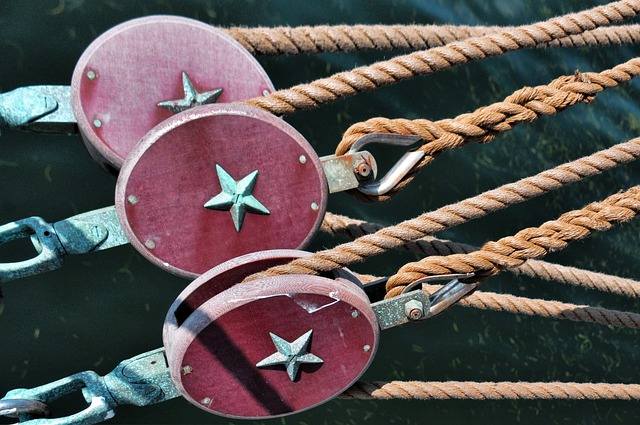Tall ship sailing is an exciting and rewarding activity. Unmatched is the sensation of the wind in your hair, the sound of the waves, and the aroma of salt in the air.
Tall ship sailing, however, need expertise, knowledge, and experience. The optimal knots to utilize are a crucial part of sailing large ships.
We’ll give you the ideal knots for a tall ship sailing in this in-depth tutorial so you can easily explore the open seas.
Knots for Sailing Tall Ships
1. The Bowline Knot
The bowline knot is a popular knot used in sailing and for good reason. It creates a non-slip loop at the end of a rope, making it perfect for securing halyards, sheets, and mooring lines.
The bowline knot is reliable and easy to untie, even after it has been under great strain. To tie the bowline knot, create a small loop in the line, then lead the free end of the line through the loop, around the standing part, and back through the loop.
2. The Cleat Hitch
The cleat hitch is an essential knot for securing a line to a cleat. It is a simple knot that is easy to tie and untie, even when under load. The cleat hitch is used to secure lines such as halyards, sheets, and mooring lines.
To tie the cleat hitch, wrap the line around the base of the cleat twice, then cross the standing part of the line over the wraps and loop it under the horns before creating a half hitch.
3. The Rolling Hitch
The rolling hitch is a useful knot for attaching a line to another line or object, such as a spar or a fender. It is a friction knot that can be easily adjusted and is useful for securing a boat in a slip or when mooring.
To tie the rolling hitch, wrap the line around the object or line, then create a half hitch around the standing part of the line. Continue to create additional half hitches until the knot is secure.
4. The Sheet Bend
The sheet bend is a versatile knot that is perfect for joining two lines of unequal diameters, such as a halyard to a sheet. It is easy to tie and untie, even when under load. To tie the sheet bend, create a bight in the thicker line, then pass the thinner line over and under the bight before looping it back on itself and passing it under the standing end of the thicker line.
5. The Figure Eight Knot
The figure-eight knot is a stopper knot that is used to prevent a line from running out of a block or to stop the end of a line from passing through a grommet. It is straightforward to tie and untie, making it useful in situations where quick action is required.
To tie the figure-eight knot, create a loop in the line, then pass the free end over and around the standing part of the line before tucking it back through the loop.
6. The Clove Hitch
The clove hitch is a popular knot in sailing and is widely used for securing a line to a piling or post. It is easy to tie and untie and is useful for situations where the load on the knot is not constant.
To tie the clove hitch, wrap the line around the post or piling twice, then cross the standing part of the line over the wraps and loop it under itself before creating a half hitch.
Videos
We’ve put together some videos to help you easily learn how to tie knots.
Tips for Tying Knots
Perfectionism is attained via practice. You’ll get better at knotting the more you practice it. Spend some time becoming comfortable with the knots you’ll be utilizing while sailing.
Make use of sturdy rope. How well your knots hold up can be greatly influenced by the quality of your rope. Look for ropes that are sturdy, long-lasting, and simple to handle.
Keep your rope dry and spotless. Moisture, sand, and dirt can weaken your rope and make knotting more challenging. Before making any knots, make sure your rope is dry and clean.
Learn the proper terminology. Knowing the proper terminology for the different parts of a knot can help you understand how to tie it properly.
Use the right knot for the job. Not all knots are created equal. Make sure you’re using the right knot for the job at hand.
Always double-check your knots. Before setting sail, always double-check your knots to ensure they’re tied correctly and securely.
Common Mistakes to Avoid
To guarantee a secure and successful journey, some typical errors should be avoided when making knots for tall ships. The following are some of the most typical errors to avoid:
- Using the incorrect knot for the task – When a knot is tied incorrectly, it may come undone or not hold up under pressure, among other issues. Verify that you are using the appropriate knot for the task at hand.
- Not tying the knot properly – Even if you use the right knot, it won’t work if it’s not tied properly. Learn how to tie each knot correctly by taking your time.
- Not securing the knot tightly enough – A loose knot can be dangerous, as it can come undone or slip under pressure. Make sure each knot is secured tightly.
- Using old or worn-out rope can cause knots to lose their strength and even break under strain. Use only top-notch, well-maintained rope, please.
- Rushing through the process of making a knot – Although tying a knot can take some time, it’s crucial to take your time and do it properly. Rushing through the process of knotting might result in errors and potentially hazardous circumstances.
- not examine knots before launching a ship Even if you’ve tied a knot properly, you should check it again before setting sail to make sure it’s still strong and in good shape.
In Summary
In conclusion, knowing the best knots for sailing tall ships is a critical aspect of seamanship.
The bowline knot is perfect for securing lines, while the cleat hitch is essential for attaching lines to a cleat. The rolling hitch is useful for attaching lines to other lines or objects, while the sheet bend is perfect for joining lines of different diameters.
The figure-eight knot is an excellent stopper knot, and the clove hitch is ideal for securing lines to posts or pilings.
Mastering these knots will help you sail with confidence and skill, ensuring a safe and enjoyable sailing experience.
We hope that this guide has been helpful and wish you happy and safe sailing!




![The Best Navigation Tools for Tall Ship Sailing [Ultimate Guide] The Best Navigation Tools for Tall Ship Sailing [Ultimate Guide]](https://www.tallshipssunderland.com/wp-content/uploads/2023/03/navigation-tools-150x150.jpg)

![How to Train to Become a Tall Ship Sailor [6 Steps] How to Train to Become a Tall Ship Sailor [6 Steps]](https://www.tallshipssunderland.com/wp-content/uploads/2023/03/tall-ship-sailor-150x150.jpg)